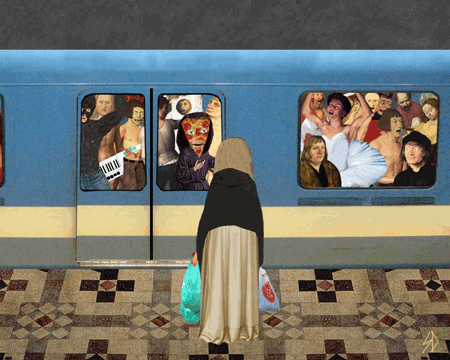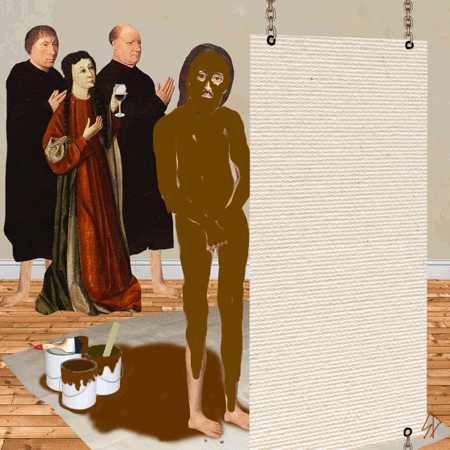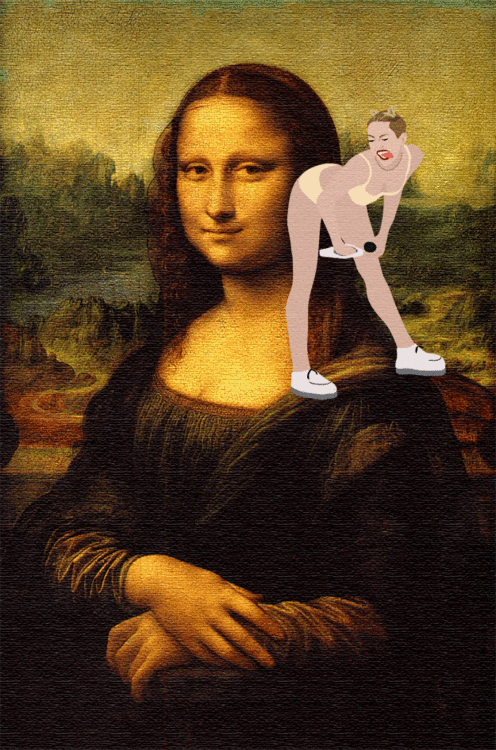empathy
Are Classic Paintings Doomed To Be Internet Jokes?

Earlier this summer when the Chicago Blackhawks were at the brink of winning the Stanley Cup, the Art Institute of Chicago ran a brilliantly curated social media campaign in support of the ice hockey team. They began releasing daily Facebook photo-updates with paintings from their collection that came with an opportune twist. The farmers from Grant Wood’s American Gothic, for instance, now sported Blackhawks helmets while Rembrandt’s Old Man with a Gold Chain proudly wore his No. 50 jersey. Even one of Van Gogh’s pink haystacks showed up with a helmet on, followed by the caption: “Stack up the wins, Blackhawks!” (kudos to the pun department at the Art Institute). Despite the mediocre photoshop jobs, they got the main job done: going viral. Art-savvy followers and sports fans alike were sharing the images as if the championship depended on it. Yet, not surprisingly, haters also came in hordes. “Oh, buh-RUH-thur! Is nothing sacred?” wrote one commenter, while some went on to call the Art Institute’s actions dumb, tacky and stupid – others even went as far as to call their actions “defacement” (whether some of the commenter’s knew about the existence of photoshop is still unclear to me).

One particular commenter caught my attention; a troll who had been policing and shutting down the enthusiastic responses to a Renoir parody with comments like: “’Fun’ is one thing, desecrating art to promote a professional sports franchise is another thing entirely. Sorry, but your idea of ‘fun’ is selfish and idiotic.” Ouch. And despite knowing better than to engage in anonymous social media banter, I decided to put in my two cents in that particular conversation, defending the Art Institute for their clever social media campaign and even claiming that this viral reach – via silly and banal art appropriations – was a positive thing; that it may generate interest in these paintings from the general public outside of the art sphere (which in my opinion is a great thing). My comment was received to much acclaim by those involved in the conversation, except the troll of whom we never heard from again. And I thought I was right. But five months later, my then-position and wishful thinking that these parodies have any real value has changed. Or at least it's been conflicted.
Recently, there’s been a remarkable surge of viral content featuring old classic paintings that appear with a “modern” twist. You’ve most likely seen a few show up on your Facebook news feed from time to time or tumbling down the tumblr hole: from the bizarre GIFs of Renaissance paintings by Scorpion Dagger to that hilarious video of animated paintings by The Elegant Gentleman’s Guide to Knife Fighting (an Australian comedy sketch show) to the technology-savvy paintings of Kim Dong-kyu’s Art x Smart project — just to name a select few. These images of altered classic paintings are popping up more than ever. If we discard the unlikely reason that this is mere coincidence, what are we to make of this trend? Have these paintings become boring in their original state to our modern sensibilities? What has happened to our taste? Is it a result of the Internet’s effect on our shorter attention spans, where we now lack the patience to look at a painting if it doesn’t deliver the punch line quick enough? Are these classic paintings destined to be remembered as Internet jokes by a generation that prefers tumblr and GIFs to a museum and a painting?
Animations by The Elegant Gentleman's Guide To Knife Fighting.
Don’t get me wrong, the above animations are relentlessly hilarious – my personal favorite is “Maria” at minute 2:09 who “likes shoplifting, #newbike.” I like it so much that whenever I now spot a similar painting – say, Velazquez’s Las Meninas – the image of a stolen bike underneath that oddly shaped dress will forever tickle my thoughts. Humor as a vehicle for information is nothing new; it is precisely how comedians are able to make their jokes relatable and funny. But are shits and giggles, in this particular art context, serving to open up these works of art to us? Or, on the contrary, further conceal our sincere interest in exchange for a quick laugh? Let's take a look at some of these plot twists.
One-liners With A Message
Take the "Art x Smart" project by Kim Dong-kyu as an example of appropriated work whose fatal punch line doesn't allow room for much else once you "get it."

In Dong-kyu's version, Munch’s famed screamer is no longer consumed by the space-bending anguish of his existential turmoil. Instead, his expression is banally equated to that feeling you get when you accidentally break your iPhone. #Relatable?

Van Gogh’s room, on the other banal hand, has been coated with a hispterish aesthetic by the additions of a fixie bike and apple electronics. The bohemian lifestyle is put into contradiction, bringing forth an image that is too ironic to be taken seriously (I guess we can only chuckle at it).

The formula for these one-liners is simple – and apparently successful, judging by the amount of attention they've been getting. But despite how simplistic these two-step digital collages may appear, Dong-kyu does offer a sprinkle of truth: I really can’t imagine a “wonderer above the sea of fog” who would not feel compelled to photograph the unique sight and share it with his friends and followers on twitter and instagram, #sublime.
One-liners With No Message
And then there are those meaningless adulterations where no message is found at the end of the chuckle. Worth1000, an image manipulation and contest website, is responsible for a recent re-emergence of Renaissance superheroes. Superhero ModRen is their photo effects gallery where one may upload a recreation of classic Renaissance paintings with modern-day comic book superheroes.



Heheh. Ok, moving on. — See what I mean?
Plot Twist: Multi-liners With New Message
Yet from the current trend of "pimp my painting," one body of work stands out as unique: the hilariously bizarre GIFs of James Kerr a.k.a. Scorpion Dagger. Maybe it is the clever, witty and nonsensical humor he applies to his few-seconds-long works or perhaps it is his ability to infuse old aesthetics with new content, but the results are…

What's remarkable about Kerr's "parodies" is that they often reject that very label. He gives these moving cutouts brand new personalities and circumstances that it is hard to picture them in their original context. The most successful of Kerr's works are those that take us to the furthest away from their point of origin.

I'm sure that whatever similarities the above GIF has with Berlin's own U-Bahn is mere coincidence (it is actually the artist's ode to Monreal's rush hour). What we cannot be sure about, however, is what exactly is happening here; the who, the when and the what-the-hell. Arriving at this point of not-knowing gives us the opportunity for interpretation; a place where we enter the work through our own experiences instead of relying on the one-liner joke to "get it" and quickly move on.

We don't want to move on, there so much to chew on here. We want to talk about them, share them with our friends and follow the various strands of possible meanings. Whether intentional of made up on the spot, these works do provide the rare luxury of both entertainment and substance.

Despite the digital limitations of the medium, it's not hard to imagine these GIFs outside of tumblr and hanging in the walls of a gallery IRL.

But ultimately, in the age of the Internet where we like things with a mouse click and share visual punch-lines across social media channels, it seems that classic paintings will continue to serve as a fertile playground where to laugh at popular trends of the moment. It’s just that I don’t know what is undervalued by Miley Cyrus twerking on the Mona Lisa: the banality of Cyrus’s twerk when put up against the high-brow of La Gioconda or the painting itself that only pops up on our newsfeed, more often than not, when it's been parodied yet again. Sigh.

Article by Jovanny Varela-Ferreyra
For more articles on Art trends & the Internet, check out these juicy links:
Wait, There's Artists On Vine?
Has Contemporary Art Become Hipster?
Be the first to write a comment.
Your feedback
